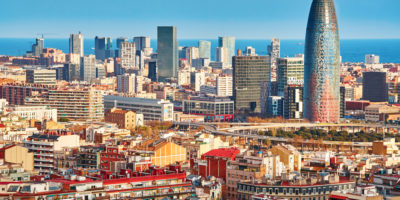-
USA
USA – Visto per investitori e lavoratori dipendenti
22 Marzo 2021
- Lavoro
- Immigrazione
Con la nuova amministrazione statunitense, ci si aspetta grandi cambiamenti nell’ambito dell’immigrazione legata al business, ossia a quella parte della legislazione sull’immigrazione relativa ai visti per investitori e per lavoratori dipendenti. Anche se alcune delle più importanti riforme dovranno essere approvate dal Congresso statunitense (come, ad esempio, l’introduzione di un visto per start-up o la rimozione del numero massimo di visti H-1B per le occupazioni speciali), le società straniere, gli investitori e i soggetti con abilità straordinarie possono già godere di un ambiente più amichevole alla luce dei nuovi executive orders emanati di recente dal Presidente Biden ed delle nuove direttive dell’U.S. Citizenship and Immigration Services (USCIS).
Di seguito sono elencati e analizzati alcuni dei requisiti necessari all’ottenimento di visti per investitori e di visti per i lavoratori dipendenti, che ci si aspetta verranno ora interpretati maggiormente a favore dei richiedenti.
E-2 Non Immigrant Temporary Investor Visa
Per coloro che sono seriamente interessati ad un progetto di business di notevole importanza, il governo statunitense offre il cosiddetto E-2 Investor Visa, in base al paese di cittadinanza dell’investitore e in base a specifici requisiti:
Quando l’investimento è considerato adeguato?
Affinché l’investimento venga considerato adeguato, esso deve essere “attivo”, ossia deve essere reale, concreto, ed essere il risultato di un impegno finanziario serio. L’investimento deve essere rischioso, quindi un mero trasferimento di capitale da un conto corrente straniero non sarà sufficiente per ottenere un visto E-2. Sono previsti poi una serie di requisiti aggiuntivi, quali, ad esempio, l’acquisto di materiale, l’affitto di un locale commerciale, etc.
A quanto ammonta l’investimento per ottenere un visto?
La legge richiede che l’investimento sia substantial, ossia sostanziale. Di conseguenza, l’ammontare dell’investimento è relativo all’industria specifica. Ad esempio, se si vuole aprire un nuovo ristorante sulla Fifth Avenue a New York City, con 100 posti a sedere, US $100.000 non saranno sufficienti. Dall’altro lato Visti E-2 sono stati approvati con un investimento di poco superiore ai US $80.000, dal momento che i costi iniziali erano relativamente bassi.
Per essere substantial l’investimento deve essere:
- proporzionale al valore del business (nel caso di un business già esistente)
oppure
- sufficiente per garantire la creazione di un nuovo business
- non marginale
Con l’investimento si dovrà essere in grado di creare nuove opportunità di lavoro, non solo per l’investitore e la sua famiglia, ma anche per cittadini americani.
Nel caso di start-up, il business plan iniziale dovrà indicare, in grande dettaglio, come queste opportunità di lavoro per cittadini americani verranno create.
Uno dei migliori vantaggi del visto E-2 è che l’investitore potrà poi assumere e sponsorizzare altri visti E-2 per lavoratori essenziali e manager che abbiano la stessa nazionalità dell’investitore principale.
O-1 Extraordinary Ability Visa
Il visto O-1 viene concesso a coloro che dimostrano quanto segue:
- extraordinary ability nella scienza, educazione, business, o sport; oppure
- extraordinary ability nelle arti (che comprende anche qualsiasi attività creativa). Fotografi, designers, architetti, scrittori e anche parrucchieri e chef sono tutti considerati artisti ai fini dell’immigrazione e possono qualificarsi per un visto O1; oppure
- raggiungimenti extraordinary in ambito cinematografico e nell’industria televisiva.
La differenza tra queste tre categorie sta nella prova dei requisiti.
I casi più difficili da provare sono quelli per soggetti con abilità straordinarie nella scienza, educazione, business ed atletica perché il visto O-1 viene concesso solo a chi è al top del rispettivo campo di specializzazione, rappresentando quindi una percentuale molto bassa.
Un onere della prova minore viene richiesto per chi vuole ottenere il visto nell’ambito cinematografico e nel settore televisivo. In questo caso, si richiede che il beneficiario del visto sia outstanding ossia che il beneficiario sia conosciuto ed abbia capacità eccezionali.
Infine, la categoria per coloro che hanno abilità straordinarie nelle arti è la più facile da provare perché un livello di distinzione è sufficiente. Per dimostrare tale livello di distinzione il beneficiario dovrà presentare prova documentale della sua abilità straordinaria nel campo specifico.
Per ottenere un visto O-1 il beneficiario deve soddisfare almeno tre categorie su sei, dimostrando, in genere, che si sono articoli di giornale che parlano del beneficiario e delle sue abilità, che il beneficiario ha ricevuto dei premi e includendo lettere di presentazione.
Nella domanda di visto O-1 il richiedente deve essere o un datore di lavoro americano o un agente americano. Nel primo caso, il datore di lavoro deve essere una persona o un business che andrà ad assume il beneficiario in maniera esclusiva. Un contratto di lavoro o almeno un riassunto dei termini di un contratto orale può essere prova sufficiente per dimostrare la relazione datore di lavoro / dipendente. Dall’altro lato, un agente americano può essere un agente nell’ambito di specializzazione e business del richiedente e può presentare la domanda di visto senza che ci sia un contratto di esclusiva con il beneficiario. In questo ultimo caso, si dovrà presentare, con la domanda, un programma di eventi già pianificati o proposti al quale il beneficiario prenderà parte.
H-1B Specialty Occupation
Il 1 Aprile di ogni anno, l’USCIS inizia ad accettare domande per visti H-1B, meglio conosciuti come work visas, ossia visti lavorativi.
La caratteristica principale di questa categoria di visti è la limitazione nel numero di visti H-1B concessi dall’USCIS ogni anno. Solo 85.000 visti di questo tipo possono essere emanati annualmente per richiedenti in tutto il mondo. Questo numero è poi ridotto per molti beneficiari, dal momento che 20.000 di questi 85.000 visti sono riservati a coloro che hanno lauree di un certo livello, come, ad esempio, master, ottenuti negli Stati Uniti. Di conseguenza, sono lasciati solo 65.000 visti per il resto dei beneficiari.
Avendo a che fare con un numero assai elevato di domande di visto H-1B, l’USCIS ha creato un sistema di lotteria computerizzata che decide automaticamente quali domande devono essere valutate (ma non approvate). Al contrario, quelle non scelte non verranno prese in considerazione. I fortunati che sono stati scelti nella lotteria avranno vedranno quindi le proprie domande prese in considerazione nel merito dall’USCIS.
Nel 2020 è stato istituito un sistema di registrazione elettronica per coloro che vogliono fare richiesta di un visto H1B, sia per limitare lo scambio di dati e l’ammontare di documentazione presentata, che per ridurre i costi totali dei datori di lavoro che vogliono sponsorizzare un visto H-1B. Il sistema prevede una semplice registrazione dell’azienda sponsorizzante e del candidato, assieme al pagamento di soli $10.
Una volta terminato il periodo di registrazione, che dura 14 giorni e si svolge solitamente nella seconda metà del mese di Marzo, l’USCIS selezionerà, a caso, coloro che possono procedere con la domanda di visto H-1B che verrà poi regolarmente analizzata dall’USCIS. I soggetti selezionati dovranno presentare tale domanda di visto H-1B entro 90 giorni.
L’USCIS approverà una domanda di visto H-1B se sono soddisfatti criteri specifici:
- deve esserci una relazione di datore di lavoro / dipendente. Una relazione di lavoro indipendente non è sufficiente. L’USCIS verificherà se il datore di lavoro ha controllo sulle attività del dipendente e se il dipendente è incluso nell’organizzazione del datore di lavoro.
- il beneficiario deve essere assunto nell’occupazione specializzata che corrisponda alla sua precedente carriera professionale o di studi. In altre parole, l’USCIS apre le porte solo agli stranieri competenti. Non solo il richiedente deve avere una laurea nel campo nel quale intende lavorare, ma anche la posizione offerta deve, per sua natura, richiedere almeno una laurea. L’USCIS, in genere, si appoggia al Dipartimento del Lavoro per verificare se una particolare occupazione richiede almeno una laurea. Mentre certe occupazioni, quali avvocati, medici, architetti etc., non comportano, di solito, problematiche circa la qualificazione del candidato, altre professioni, come specialisti in marketing, analisti, graphic designer e molti altri creano spesso problematiche al riguardo.
- il salario offerto dal datore di lavoro al beneficiario deve corrispondere almeno al salario medio offerto per simili posizioni nella stessa area geografica. Per stabilire il salario medio, l’USCIS utilizza i dati messi a disposizione dal Dipartimento del Lavoro, affinché’ vengano eliminate domande senza fondamento. Questo fa si che il visto H-1B sia riservato solo ai più bravi richiedenti stranieri.
L-1 Intracompany Transferee Visa
I visti L-1 permettono a società che hanno una presenza sia all’estero che negli Stati Uniti (sia per business già esistenti negli USA che per business nuovi) di trasferire i proprio dipendenti negli Stati Uniti, siano essi manager o executives (L-1A) oppure dipendenti con conoscenze specializzate (L-1B).
Il beneficiario del visto deve aver lavorato per la società all’estero per un anno consecutivo nei tre anni precedenti la data della domanda di visto.
Avere capacità manageriale significa che il beneficiario ha la capacità ed esperienza per supervisionare dipendenti e che ha le competenze di gestione della società o di un suo ramo.
Possedere conoscenze specializzate significa che il beneficiario ha una conoscenza specifica e specializzata del prodotto o del servizio offerto dalla società, dei macchinari aziendali, o del modus operandi dell’azienda, oppure che il beneficiario ha un livello specifico di conoscenza o esperienza circa i processi produttivi della società.
Il numero di artisti negli Stati Uniti è notevole. O per lo meno, gli “artisti” così come definiti dalle regolamentazioni sull’immigrazione. Infatti, uno dei visti più diffusi è il visto O-1, detto anche “visto artistico”. Per essere più precisi, il visto O-1 non è riservato solo ad artisti, bensì a coloro che sono in grado di dimostrare extraordinary abilities in alcuni settori, tra cui appunto l’arte.
L’O-1 visa è riservato a persone che dimostrano: 1) extraordinary abilities nelle scienze, istruzione, business e atletica; 2) extraordinary abilities nell’arte. Questa categoria non include solamente le classiche belle arti, arti performative e visive ma ogni attività creativa. Fotografi, designers, architetti, scrittori e persino coiffeurs e chefs sono tutti considerati “artisti” secondo la regolamentazione sull’immigrazione e si possono, quindi, qualificare per l’ottenimento di un visto O-1 grazie; oppure 3) extraordinary abilities nell’industria cinematografica o televisiva.
La differenza tra le tre categorie risiede nella maggior o minore difficoltà nel provare le extraordinary abilities. I casi più difficili da provare sono quelli relativi alle extraordinary abilities nelle scienze, nell’istruzione, nel business e nell’atletica, in quanto riservati a coloro che sono riusciti ad arrivare to the very top del proprio settore, rappresentando, quindi, solo una piccola percentuale. Uno standard probatorio meno rigoroso è richiesto per coloro che vogliono dimostrare extraordinary abilities nell’industria cinematografica o televisiva, dove è richiesto che il soggetto sia outstanding, ovvero eccezionale e illustre. Infine, la categoria più facile da provare è quella per soggetti con extraordinary abilities in arts, in quanto un mero livello di distinction è ritenuto sufficiente. Il requisito della Distinction viene considerato soddisfatto quando dei risultati positivi nel proprio settore sono corroborati da prove documentali. La categoria dell’arte è, dunque, intesa in senso molto ampio ed è la più semplice da provare. Non sorprende, quindi, che, almeno nel campo dell’immigrazione, gli Stati Uniti siano un paese che accoglie positivamente gli “artisti”.
Ulteriori differenze tra le categorie risiedono nel tipo di prove da presentare all’United States Citizenship and Immigration Services (USCIS). Più nello specifico, al riguardo, il primo gruppo, quello riservato ad individui con extraordinary abilities nelle scienze, nell’istruzione, nel business e nell’atletica e denominato O-1A si distingue dalle altre due categorie (extraordinary abilities nelle arti e nell’industria cinematografica e televisiva), raggruppati sotto la dicitura O-1B per le seguenti ragioni.
Per ottenere un O-1A bisogna dimostrare di essere arrivati al top nel proprio settore provando:
- La ricezione di un premio di estrema rilevanza internazionale, come ad esempio il Premio Nobel;
oppure
- Soddisfacendo almeno tre dei seguenti requisiti:
- Ricezione di un premio riconosciuto o nazionalmente o internazionalmente come simbolo di eccellenza nel settore;
- Appartenenza ad associazioni che richiedono ottenimenti di risultati di rilievo nel settore;
- Articoli o altre pubblicazioni che parlino dei successi del soggetto che fa richiesta del visto nel campo specifico;
- Contribuzione scientifiche o di business nel settore di rilevanza;
- Essere autore di pubblicazioni scientifiche nel settore;
- Aver ricevuto o ricevere uno stipendio (o altre forme di compensazione) elevato se comparato ad altri nel settore;
- Aver assunto le funzioni di giudice del lavoro di altri nel settore;
- Essere stati impiegati in ruoli chiave per enti/organizzazioni di rilievo.
Per ottenere un O-1B, invece, bisogna:
- aver ricevuto o anche “solo” essere stato nominato per un premio di estrema rilevanza internazionale, come ad esempio un Oscar, Emmy, oGrammy;
oppure:
- Soddisfare almeno tre di questi requisiti:
- Aver rivestito un ruolo cruciale in rappresentazioni illustri;
- Aver ottenuto fama nazionale o internazionale così come evidenziato da articoli di giornale o altre pubblicazioni;
- Aver rivestito un ruolo cruciale in organizzazioni o enti illustri;
- Aver ottenuto un successo testimoniato dal pubblico (al botteghino) o dalla critica;
- Aver ottenuto un considerevole riconoscimento per i successi conquistati così come evidenziato da premi o da testimonianze di esperti e critici di un determinato settore.
- Aver ricevuto o ricevere uno stipendio (o altre forme di compensazione) elevato se comparato ad altri nel settore.
E’ opportuno ricordare che, all’interno dell’O-1B, ci sono due sottocategorie il cui standard probatorio è differente: più esigente quello per soggetti dell’industria cinematografica e televisiva (outstanding, ovvero eccezionale e illustre), più facile da provare per soggetti che operano nelle arti (distinct, ovvero molto conosciuta/o).
In relazione alle prove da presentare, un O-1 case si dimostra tramite articoli di giornale (o simili pubblicazioni), premi (o comunque riconoscimenti ufficiali) e testimonianze/lettere di presentazione.
In un O-1 Application, il Petitioner sarà o un US employer o un US Agent. Il primo è un classico datore di lavoro che utilizzerà le extraordinary abilities del candidato in maniera esclusiva. In tal caso, un vero e proprio contratto di lavoro o, perlomeno, una sintesi scritta e firmata dalle parti dell’accordo orale può essere considerata prova sufficiente circa l’esistenza del rapporto di lavoro. Uno US Agent, invece, è un soggetto o un ente operante nella stessa industria in questione, che sponsorizza il candidato pur senza impegnarsi ad impiegare lo stesso in via esclusiva. In questo caso, piuttosto che un contratto di lavoro, è necessario includere nella domanda di visto un percorso/itinerario di quelle che saranno le attività del candidato.
Il visto O-1 viene concesso per un tempo corrispondente alla durata dell’evento a cui prenderà parte il soggetto con extraordinary abilities fino a un massimo di tre anni e può essere prolungato qualora la durata dell’evento in questione venga estesa. A meno che… il possessore dell’O-1 non soddisfi già i requisiti per divenire un residente permanente. Infatti, l’O-1 visa è uno di quei visti che gode di una corsia preferenziale verso l’ottenimento della tanto desiderata green card.
Spanish Law on Entrepreneurship (Law 14/2013) has approved new cases where foreigners from non-European Union countries can obtain the residence permit in Spain through the execution of investments:
- Investments in real estate for an amount equal or higher than € 500.000 (Five Hundred Thousand Euros). The investment can be made in one or more properties, but at least € 500.000 should be free of encumbrances (mortgage, i.e.). If the price is higher than € 500.000, the rest of the amount could be paid through mortgage.
- Financial investments for a value equal or higher than 1 million Euros. This type of investment includes listed and non-listed shares, in case of non-listed shares they could be from already operating companies or newly incorporated ones, investment funds, and deposits in Spanish banks.
- Investment in Spanish sovereign debt for an amount equal or higher than 2 million Euros.
- To carry on a business project in Spain that was considered as being of public interest. To this purpose, one of these conditions should be met: creation of jobs, execution of an investment that has a positive impact in the region where it is located, or a relevant contribution to scientific or technological innovation.
The visa granted through the execution of these investments is valid during at least one year, and in order to obtain the residence permit some other requirements should be met:
- to not stay previously in Spain in an illegal situation,
- to have more than 18 years,
- to not have criminal records,
- to have a health insurance (hired from a company operating in Spain)
- to have financial means for the stay in Spain (i.e. a bank deposit, or income from leases or dividends. Payroll does not qualify for this purpose).
If the above requirements are met, a two years residence and work permit could be granted. After this term, the residence permit can be extended for successive five years periods. The investments should be kept during all these periods. This permit does not request the foreigner to live in Spain for more than six months; therefore it will not be cancelled if the foreigner lives in another country.
The residence and work permit is granted to the individual who executes the investment. If he/she is married and/or has children or ancestors who depend on the investor, it is possible to apply for their visa at the same time or later on. It is possible to execute the investment through a company owned by the investor, provided it is not a company domiciled in a tax heaven country.
The Spanish visa allows free movements within the EU countries (Schengen space). The valid travelling document is the passport.
Foreigners who wish to carry on a self-employment project in Spain could obtain the work and residence permit, but through a different procedure than the above mentioned, and these cases the minimum investment amount is lower.
Investment in real estate
The investment in real estate could be in residential, commercial or industrial properties. The property could be leased to third parties before or after the acquisition, or used by the investor. For ambitious investors, there are several possibilities to structure the investment in buildings and apartments and to a higher return of the investment.
There are some costs related to the acquisition of real estate: the acquisition itself is taxed by Transfer Tax at rates ranging from 6 to 10% on the acquisition price, depending on each Spanish region where the property is located, to be paid by the buyer. Besides, the buyer should pay the Notary Public and Property Registrar’s fees, which approximately amount 3% of the acquisition price (the addition of both of them). These amounts are paid once, when the property is acquired.
The annual costs related to the ownership of real estate in Spain are the following ones:
- IBI or local property tax, whose amount is calculated based on the value and location of the property.
- “Community expenses”, that is those expenses related to the maintenance of the common areas of the building where the property is located: cleaning, lighting, etc.
- In some cases, also a small tax for garbage should be paid to the Town Council.
- Owners should file the Spanish Personal Income Tax Return, and pay a percentage between 1,1% and 2% of the property’s “cadastral value” (official value), in case the property is not leased to a third party. If the property is leased, the owner should also file the Personal Income Tax Return based on the amounts obtained from the lease.
Besides, owners should also pay the expenses related to their property: ordinary maintenance expenses, insurance, electricity and water, etc.
In Spain, the property right is considered as a full right, which implies that the owner can use the property by himself, can lease it to third parties, can mortgage or encumber it, can sell or gift it to any third party and can pass it to his heirs through a will.
The only limits to the use of the property by its owner or the persons appointed by him are those established by the civic rules regarding noises, pets, exterior image of the property, etc.
Regarding the lease of the property, in principle it is free, and the rights and obligations of landlord and tenant are those provided by the private lease agreement entered between both parties and the Spanish Urban Leases Law (Ley de Arrendamientos Urbanos). However, nowadays many Spanish cities (and specially Barcelona) have approved strong limits to the so called touristic leases, which are the short term (days or weeks) leases, and request a special license.
It is important to point out that foreigners who become residents in Spain can grant their will according to Spanish inheritance laws (according to EU Regulation 650/2012), which slightly vary depending on each Spanish region. In Catalonia, for example, the testator can freely appoint who will be his heirs.
Financial investment
Financial investments can be executed through different types of targets, being always the minimum amount 1 million Euros:
- Shares of companies listed in the Spanish Stock Market.
- Shares of non-listed companies, which could be already operating companies or newly incorporated ones. In both cases, there are no limits as regards the percentage of shares that can be owned by foreigners, and the activity sectors restricted to non EU foreign investment are very few (gambling, defense, aviation, TV and radio). Foreigners can be appointed Directors of Spanish companies with the only requirement of having previously obtained the so called “N.I.E.”, which is the Spanish identification number for foreigners.
In case of a newly incorporated company, the € 1 million requested as investment would constitute the company’s share capital, and can be used for the startup of the company’s activities: for example, acquisition of goods, payment of salaries and rentals, payment of purveyors and subcontractors, etc.
Spanish companies have access to all European markets and have a privileged position for trading with Latin American countries.
- Investment funds: Spanish financial entities offer a very wide range of investment funds, from very conservative to high risk.
Deposit in a bank
The main advantage of a real estate investment compared to a financial investment is that the requested amount is only € 500.000 for real estate, while for a financial investment is twice this amount. During the past years since the Law on Entrepreneurship became in force, investment in real estate has been the most popular way for obtaining the residence permit in Spain, probably because at that time (2013-2016) real estate market prices were quite low due to the crash in 2008.
However, the process to acquire a property in Spain is not so easy compared to the acquisition of a share in an investment fund or making a bank deposit: the investor has to choose the property, which normally requires one or two visits to Spain, the price and sale conditions have to negotiated and drafted, the purchase deed has to be signed before a Notary Public (by the investor or his proxy), there are taxes and expenses related to the acquisition, and once the property is acquired, it is necessary to pay ongoing expenses and taxes, and maintain the property in good condition.
Compared to this, the investment in funds or making a bank deposit only requires one visit to the bank by the investor, in order to sign the correspondent documents. There are not related taxes or expenses, and the liquidity of the investment is full (that is, the investment can be sold at any moment, quite probably at the same or at a higher price, but this is not guaranteed for real estate investments).
How to open and operate a bank account in Spain
In Spain, banks apply the regulations regarding anti-money laundering, which include the KYC (Know Your Client) rules and the obligation to prove the legal origin of the funds. The KYC rules imply the need for the investor to appear personally before the bank at least once, previously to operating the bank account. The legal origin of the funds can be proved through different means:
- In case of employees, through the payroll splits, or a certificate issued by the employer, or the investor’s personal income tax return.
- In case of self-employed individuals, through their personal income tax return, or another type of documents proving their professional activity.
- In case of company owners, through the company’s financial statements.
- If the investor has obtained the funds necessary for the investment through personal loans, the loan agreements should be provided, plus the documents proving the legal origin of the funds provided by the lenders.
- Other documents, for example, regarding dividends or income from the lease of properties owned by the investor could be provided.
All documents should be legalized by a Notary Public or the Spanish Consulate, and sworn translated into Spanish.
Please note that this article is aimed to provide a general overview on Spanish rules regarding the above matters, but it does not constitute any kind of comprehensive information on them, and in any case specific legal advice should be sought prior to taking any decision.
Individuals coming to Portugal and here becoming residents for the first time, can be entitled to some important tax benefits under the “non habitual resident rules”. These rules are an important contribution for making Portugal one of the most attractive destinations for retired individuals, but also for entrepreneurs.
Who can benefit?
A non habitual resident is an individual becoming resident for tax purposes in Portugal for the first time in the last five years period. To become resident for tax purposes, one should be in Portugal for more than 183 days in any 12 months period or for a shorter period but in such conditions that the intention of becoming resident is sufficiently clear. After becoming resident for tax purposes and register as such before the Tax Authorities, the individual must register as a non habitual resident to be able to benefit from this regime.
High Value Added Activities.
Some of the benefits under the non habitual resident rules are only applicable to income arising from high value added activities. These activities include architects, engineers, artists, auditors and tax consultants, medical professions, university teachers, top managers and other liberal professionals in areas such as informatics (software and hardware) development and consultancy, science investigation and design.
For how long?
The benefits arising from the non habitual resident status are valid for a ten year period and depend on the individual remaining as resident in Portugal for tax purposes. If, for any reason, the individual ceases to be resident, he can later benefit from the remaining period by becoming resident again.
What are the benefits?
Individuals becoming non habitual resident benefit from a more favorable tax treatment regarding both income from Portuguese source and income from foreign sources.
As to the income from Portuguese source arising from employment and self-employment, it is subject to a special tax of 20%. This benefit is only applicable to non habitual residents earning income from high value added activities.
As to the income from foreign sources arising from employment and pensions, it is exempted from taxes in Portugal, in most cases. This exemption also includes income arising from self-employment in high value added activities, and from intellectual and industrial property, capital and real estate gains.
USA – Il Visto Artistico
6 Giugno 2019
-
USA
- Immigrazione
Con la nuova amministrazione statunitense, ci si aspetta grandi cambiamenti nell’ambito dell’immigrazione legata al business, ossia a quella parte della legislazione sull’immigrazione relativa ai visti per investitori e per lavoratori dipendenti. Anche se alcune delle più importanti riforme dovranno essere approvate dal Congresso statunitense (come, ad esempio, l’introduzione di un visto per start-up o la rimozione del numero massimo di visti H-1B per le occupazioni speciali), le società straniere, gli investitori e i soggetti con abilità straordinarie possono già godere di un ambiente più amichevole alla luce dei nuovi executive orders emanati di recente dal Presidente Biden ed delle nuove direttive dell’U.S. Citizenship and Immigration Services (USCIS).
Di seguito sono elencati e analizzati alcuni dei requisiti necessari all’ottenimento di visti per investitori e di visti per i lavoratori dipendenti, che ci si aspetta verranno ora interpretati maggiormente a favore dei richiedenti.
E-2 Non Immigrant Temporary Investor Visa
Per coloro che sono seriamente interessati ad un progetto di business di notevole importanza, il governo statunitense offre il cosiddetto E-2 Investor Visa, in base al paese di cittadinanza dell’investitore e in base a specifici requisiti:
Quando l’investimento è considerato adeguato?
Affinché l’investimento venga considerato adeguato, esso deve essere “attivo”, ossia deve essere reale, concreto, ed essere il risultato di un impegno finanziario serio. L’investimento deve essere rischioso, quindi un mero trasferimento di capitale da un conto corrente straniero non sarà sufficiente per ottenere un visto E-2. Sono previsti poi una serie di requisiti aggiuntivi, quali, ad esempio, l’acquisto di materiale, l’affitto di un locale commerciale, etc.
A quanto ammonta l’investimento per ottenere un visto?
La legge richiede che l’investimento sia substantial, ossia sostanziale. Di conseguenza, l’ammontare dell’investimento è relativo all’industria specifica. Ad esempio, se si vuole aprire un nuovo ristorante sulla Fifth Avenue a New York City, con 100 posti a sedere, US $100.000 non saranno sufficienti. Dall’altro lato Visti E-2 sono stati approvati con un investimento di poco superiore ai US $80.000, dal momento che i costi iniziali erano relativamente bassi.
Per essere substantial l’investimento deve essere:
- proporzionale al valore del business (nel caso di un business già esistente)
oppure
- sufficiente per garantire la creazione di un nuovo business
- non marginale
Con l’investimento si dovrà essere in grado di creare nuove opportunità di lavoro, non solo per l’investitore e la sua famiglia, ma anche per cittadini americani.
Nel caso di start-up, il business plan iniziale dovrà indicare, in grande dettaglio, come queste opportunità di lavoro per cittadini americani verranno create.
Uno dei migliori vantaggi del visto E-2 è che l’investitore potrà poi assumere e sponsorizzare altri visti E-2 per lavoratori essenziali e manager che abbiano la stessa nazionalità dell’investitore principale.
O-1 Extraordinary Ability Visa
Il visto O-1 viene concesso a coloro che dimostrano quanto segue:
- extraordinary ability nella scienza, educazione, business, o sport; oppure
- extraordinary ability nelle arti (che comprende anche qualsiasi attività creativa). Fotografi, designers, architetti, scrittori e anche parrucchieri e chef sono tutti considerati artisti ai fini dell’immigrazione e possono qualificarsi per un visto O1; oppure
- raggiungimenti extraordinary in ambito cinematografico e nell’industria televisiva.
La differenza tra queste tre categorie sta nella prova dei requisiti.
I casi più difficili da provare sono quelli per soggetti con abilità straordinarie nella scienza, educazione, business ed atletica perché il visto O-1 viene concesso solo a chi è al top del rispettivo campo di specializzazione, rappresentando quindi una percentuale molto bassa.
Un onere della prova minore viene richiesto per chi vuole ottenere il visto nell’ambito cinematografico e nel settore televisivo. In questo caso, si richiede che il beneficiario del visto sia outstanding ossia che il beneficiario sia conosciuto ed abbia capacità eccezionali.
Infine, la categoria per coloro che hanno abilità straordinarie nelle arti è la più facile da provare perché un livello di distinzione è sufficiente. Per dimostrare tale livello di distinzione il beneficiario dovrà presentare prova documentale della sua abilità straordinaria nel campo specifico.
Per ottenere un visto O-1 il beneficiario deve soddisfare almeno tre categorie su sei, dimostrando, in genere, che si sono articoli di giornale che parlano del beneficiario e delle sue abilità, che il beneficiario ha ricevuto dei premi e includendo lettere di presentazione.
Nella domanda di visto O-1 il richiedente deve essere o un datore di lavoro americano o un agente americano. Nel primo caso, il datore di lavoro deve essere una persona o un business che andrà ad assume il beneficiario in maniera esclusiva. Un contratto di lavoro o almeno un riassunto dei termini di un contratto orale può essere prova sufficiente per dimostrare la relazione datore di lavoro / dipendente. Dall’altro lato, un agente americano può essere un agente nell’ambito di specializzazione e business del richiedente e può presentare la domanda di visto senza che ci sia un contratto di esclusiva con il beneficiario. In questo ultimo caso, si dovrà presentare, con la domanda, un programma di eventi già pianificati o proposti al quale il beneficiario prenderà parte.
H-1B Specialty Occupation
Il 1 Aprile di ogni anno, l’USCIS inizia ad accettare domande per visti H-1B, meglio conosciuti come work visas, ossia visti lavorativi.
La caratteristica principale di questa categoria di visti è la limitazione nel numero di visti H-1B concessi dall’USCIS ogni anno. Solo 85.000 visti di questo tipo possono essere emanati annualmente per richiedenti in tutto il mondo. Questo numero è poi ridotto per molti beneficiari, dal momento che 20.000 di questi 85.000 visti sono riservati a coloro che hanno lauree di un certo livello, come, ad esempio, master, ottenuti negli Stati Uniti. Di conseguenza, sono lasciati solo 65.000 visti per il resto dei beneficiari.
Avendo a che fare con un numero assai elevato di domande di visto H-1B, l’USCIS ha creato un sistema di lotteria computerizzata che decide automaticamente quali domande devono essere valutate (ma non approvate). Al contrario, quelle non scelte non verranno prese in considerazione. I fortunati che sono stati scelti nella lotteria avranno vedranno quindi le proprie domande prese in considerazione nel merito dall’USCIS.
Nel 2020 è stato istituito un sistema di registrazione elettronica per coloro che vogliono fare richiesta di un visto H1B, sia per limitare lo scambio di dati e l’ammontare di documentazione presentata, che per ridurre i costi totali dei datori di lavoro che vogliono sponsorizzare un visto H-1B. Il sistema prevede una semplice registrazione dell’azienda sponsorizzante e del candidato, assieme al pagamento di soli $10.
Una volta terminato il periodo di registrazione, che dura 14 giorni e si svolge solitamente nella seconda metà del mese di Marzo, l’USCIS selezionerà, a caso, coloro che possono procedere con la domanda di visto H-1B che verrà poi regolarmente analizzata dall’USCIS. I soggetti selezionati dovranno presentare tale domanda di visto H-1B entro 90 giorni.
L’USCIS approverà una domanda di visto H-1B se sono soddisfatti criteri specifici:
- deve esserci una relazione di datore di lavoro / dipendente. Una relazione di lavoro indipendente non è sufficiente. L’USCIS verificherà se il datore di lavoro ha controllo sulle attività del dipendente e se il dipendente è incluso nell’organizzazione del datore di lavoro.
- il beneficiario deve essere assunto nell’occupazione specializzata che corrisponda alla sua precedente carriera professionale o di studi. In altre parole, l’USCIS apre le porte solo agli stranieri competenti. Non solo il richiedente deve avere una laurea nel campo nel quale intende lavorare, ma anche la posizione offerta deve, per sua natura, richiedere almeno una laurea. L’USCIS, in genere, si appoggia al Dipartimento del Lavoro per verificare se una particolare occupazione richiede almeno una laurea. Mentre certe occupazioni, quali avvocati, medici, architetti etc., non comportano, di solito, problematiche circa la qualificazione del candidato, altre professioni, come specialisti in marketing, analisti, graphic designer e molti altri creano spesso problematiche al riguardo.
- il salario offerto dal datore di lavoro al beneficiario deve corrispondere almeno al salario medio offerto per simili posizioni nella stessa area geografica. Per stabilire il salario medio, l’USCIS utilizza i dati messi a disposizione dal Dipartimento del Lavoro, affinché’ vengano eliminate domande senza fondamento. Questo fa si che il visto H-1B sia riservato solo ai più bravi richiedenti stranieri.
L-1 Intracompany Transferee Visa
I visti L-1 permettono a società che hanno una presenza sia all’estero che negli Stati Uniti (sia per business già esistenti negli USA che per business nuovi) di trasferire i proprio dipendenti negli Stati Uniti, siano essi manager o executives (L-1A) oppure dipendenti con conoscenze specializzate (L-1B).
Il beneficiario del visto deve aver lavorato per la società all’estero per un anno consecutivo nei tre anni precedenti la data della domanda di visto.
Avere capacità manageriale significa che il beneficiario ha la capacità ed esperienza per supervisionare dipendenti e che ha le competenze di gestione della società o di un suo ramo.
Possedere conoscenze specializzate significa che il beneficiario ha una conoscenza specifica e specializzata del prodotto o del servizio offerto dalla società, dei macchinari aziendali, o del modus operandi dell’azienda, oppure che il beneficiario ha un livello specifico di conoscenza o esperienza circa i processi produttivi della società.
Il numero di artisti negli Stati Uniti è notevole. O per lo meno, gli “artisti” così come definiti dalle regolamentazioni sull’immigrazione. Infatti, uno dei visti più diffusi è il visto O-1, detto anche “visto artistico”. Per essere più precisi, il visto O-1 non è riservato solo ad artisti, bensì a coloro che sono in grado di dimostrare extraordinary abilities in alcuni settori, tra cui appunto l’arte.
L’O-1 visa è riservato a persone che dimostrano: 1) extraordinary abilities nelle scienze, istruzione, business e atletica; 2) extraordinary abilities nell’arte. Questa categoria non include solamente le classiche belle arti, arti performative e visive ma ogni attività creativa. Fotografi, designers, architetti, scrittori e persino coiffeurs e chefs sono tutti considerati “artisti” secondo la regolamentazione sull’immigrazione e si possono, quindi, qualificare per l’ottenimento di un visto O-1 grazie; oppure 3) extraordinary abilities nell’industria cinematografica o televisiva.
La differenza tra le tre categorie risiede nella maggior o minore difficoltà nel provare le extraordinary abilities. I casi più difficili da provare sono quelli relativi alle extraordinary abilities nelle scienze, nell’istruzione, nel business e nell’atletica, in quanto riservati a coloro che sono riusciti ad arrivare to the very top del proprio settore, rappresentando, quindi, solo una piccola percentuale. Uno standard probatorio meno rigoroso è richiesto per coloro che vogliono dimostrare extraordinary abilities nell’industria cinematografica o televisiva, dove è richiesto che il soggetto sia outstanding, ovvero eccezionale e illustre. Infine, la categoria più facile da provare è quella per soggetti con extraordinary abilities in arts, in quanto un mero livello di distinction è ritenuto sufficiente. Il requisito della Distinction viene considerato soddisfatto quando dei risultati positivi nel proprio settore sono corroborati da prove documentali. La categoria dell’arte è, dunque, intesa in senso molto ampio ed è la più semplice da provare. Non sorprende, quindi, che, almeno nel campo dell’immigrazione, gli Stati Uniti siano un paese che accoglie positivamente gli “artisti”.
Ulteriori differenze tra le categorie risiedono nel tipo di prove da presentare all’United States Citizenship and Immigration Services (USCIS). Più nello specifico, al riguardo, il primo gruppo, quello riservato ad individui con extraordinary abilities nelle scienze, nell’istruzione, nel business e nell’atletica e denominato O-1A si distingue dalle altre due categorie (extraordinary abilities nelle arti e nell’industria cinematografica e televisiva), raggruppati sotto la dicitura O-1B per le seguenti ragioni.
Per ottenere un O-1A bisogna dimostrare di essere arrivati al top nel proprio settore provando:
- La ricezione di un premio di estrema rilevanza internazionale, come ad esempio il Premio Nobel;
oppure
- Soddisfacendo almeno tre dei seguenti requisiti:
- Ricezione di un premio riconosciuto o nazionalmente o internazionalmente come simbolo di eccellenza nel settore;
- Appartenenza ad associazioni che richiedono ottenimenti di risultati di rilievo nel settore;
- Articoli o altre pubblicazioni che parlino dei successi del soggetto che fa richiesta del visto nel campo specifico;
- Contribuzione scientifiche o di business nel settore di rilevanza;
- Essere autore di pubblicazioni scientifiche nel settore;
- Aver ricevuto o ricevere uno stipendio (o altre forme di compensazione) elevato se comparato ad altri nel settore;
- Aver assunto le funzioni di giudice del lavoro di altri nel settore;
- Essere stati impiegati in ruoli chiave per enti/organizzazioni di rilievo.
Per ottenere un O-1B, invece, bisogna:
- aver ricevuto o anche “solo” essere stato nominato per un premio di estrema rilevanza internazionale, come ad esempio un Oscar, Emmy, oGrammy;
oppure:
- Soddisfare almeno tre di questi requisiti:
- Aver rivestito un ruolo cruciale in rappresentazioni illustri;
- Aver ottenuto fama nazionale o internazionale così come evidenziato da articoli di giornale o altre pubblicazioni;
- Aver rivestito un ruolo cruciale in organizzazioni o enti illustri;
- Aver ottenuto un successo testimoniato dal pubblico (al botteghino) o dalla critica;
- Aver ottenuto un considerevole riconoscimento per i successi conquistati così come evidenziato da premi o da testimonianze di esperti e critici di un determinato settore.
- Aver ricevuto o ricevere uno stipendio (o altre forme di compensazione) elevato se comparato ad altri nel settore.
E’ opportuno ricordare che, all’interno dell’O-1B, ci sono due sottocategorie il cui standard probatorio è differente: più esigente quello per soggetti dell’industria cinematografica e televisiva (outstanding, ovvero eccezionale e illustre), più facile da provare per soggetti che operano nelle arti (distinct, ovvero molto conosciuta/o).
In relazione alle prove da presentare, un O-1 case si dimostra tramite articoli di giornale (o simili pubblicazioni), premi (o comunque riconoscimenti ufficiali) e testimonianze/lettere di presentazione.
In un O-1 Application, il Petitioner sarà o un US employer o un US Agent. Il primo è un classico datore di lavoro che utilizzerà le extraordinary abilities del candidato in maniera esclusiva. In tal caso, un vero e proprio contratto di lavoro o, perlomeno, una sintesi scritta e firmata dalle parti dell’accordo orale può essere considerata prova sufficiente circa l’esistenza del rapporto di lavoro. Uno US Agent, invece, è un soggetto o un ente operante nella stessa industria in questione, che sponsorizza il candidato pur senza impegnarsi ad impiegare lo stesso in via esclusiva. In questo caso, piuttosto che un contratto di lavoro, è necessario includere nella domanda di visto un percorso/itinerario di quelle che saranno le attività del candidato.
Il visto O-1 viene concesso per un tempo corrispondente alla durata dell’evento a cui prenderà parte il soggetto con extraordinary abilities fino a un massimo di tre anni e può essere prolungato qualora la durata dell’evento in questione venga estesa. A meno che… il possessore dell’O-1 non soddisfi già i requisiti per divenire un residente permanente. Infatti, l’O-1 visa è uno di quei visti che gode di una corsia preferenziale verso l’ottenimento della tanto desiderata green card.
Spanish Law on Entrepreneurship (Law 14/2013) has approved new cases where foreigners from non-European Union countries can obtain the residence permit in Spain through the execution of investments:
- Investments in real estate for an amount equal or higher than € 500.000 (Five Hundred Thousand Euros). The investment can be made in one or more properties, but at least € 500.000 should be free of encumbrances (mortgage, i.e.). If the price is higher than € 500.000, the rest of the amount could be paid through mortgage.
- Financial investments for a value equal or higher than 1 million Euros. This type of investment includes listed and non-listed shares, in case of non-listed shares they could be from already operating companies or newly incorporated ones, investment funds, and deposits in Spanish banks.
- Investment in Spanish sovereign debt for an amount equal or higher than 2 million Euros.
- To carry on a business project in Spain that was considered as being of public interest. To this purpose, one of these conditions should be met: creation of jobs, execution of an investment that has a positive impact in the region where it is located, or a relevant contribution to scientific or technological innovation.
The visa granted through the execution of these investments is valid during at least one year, and in order to obtain the residence permit some other requirements should be met:
- to not stay previously in Spain in an illegal situation,
- to have more than 18 years,
- to not have criminal records,
- to have a health insurance (hired from a company operating in Spain)
- to have financial means for the stay in Spain (i.e. a bank deposit, or income from leases or dividends. Payroll does not qualify for this purpose).
If the above requirements are met, a two years residence and work permit could be granted. After this term, the residence permit can be extended for successive five years periods. The investments should be kept during all these periods. This permit does not request the foreigner to live in Spain for more than six months; therefore it will not be cancelled if the foreigner lives in another country.
The residence and work permit is granted to the individual who executes the investment. If he/she is married and/or has children or ancestors who depend on the investor, it is possible to apply for their visa at the same time or later on. It is possible to execute the investment through a company owned by the investor, provided it is not a company domiciled in a tax heaven country.
The Spanish visa allows free movements within the EU countries (Schengen space). The valid travelling document is the passport.
Foreigners who wish to carry on a self-employment project in Spain could obtain the work and residence permit, but through a different procedure than the above mentioned, and these cases the minimum investment amount is lower.
Investment in real estate
The investment in real estate could be in residential, commercial or industrial properties. The property could be leased to third parties before or after the acquisition, or used by the investor. For ambitious investors, there are several possibilities to structure the investment in buildings and apartments and to a higher return of the investment.
There are some costs related to the acquisition of real estate: the acquisition itself is taxed by Transfer Tax at rates ranging from 6 to 10% on the acquisition price, depending on each Spanish region where the property is located, to be paid by the buyer. Besides, the buyer should pay the Notary Public and Property Registrar’s fees, which approximately amount 3% of the acquisition price (the addition of both of them). These amounts are paid once, when the property is acquired.
The annual costs related to the ownership of real estate in Spain are the following ones:
- IBI or local property tax, whose amount is calculated based on the value and location of the property.
- “Community expenses”, that is those expenses related to the maintenance of the common areas of the building where the property is located: cleaning, lighting, etc.
- In some cases, also a small tax for garbage should be paid to the Town Council.
- Owners should file the Spanish Personal Income Tax Return, and pay a percentage between 1,1% and 2% of the property’s “cadastral value” (official value), in case the property is not leased to a third party. If the property is leased, the owner should also file the Personal Income Tax Return based on the amounts obtained from the lease.
Besides, owners should also pay the expenses related to their property: ordinary maintenance expenses, insurance, electricity and water, etc.
In Spain, the property right is considered as a full right, which implies that the owner can use the property by himself, can lease it to third parties, can mortgage or encumber it, can sell or gift it to any third party and can pass it to his heirs through a will.
The only limits to the use of the property by its owner or the persons appointed by him are those established by the civic rules regarding noises, pets, exterior image of the property, etc.
Regarding the lease of the property, in principle it is free, and the rights and obligations of landlord and tenant are those provided by the private lease agreement entered between both parties and the Spanish Urban Leases Law (Ley de Arrendamientos Urbanos). However, nowadays many Spanish cities (and specially Barcelona) have approved strong limits to the so called touristic leases, which are the short term (days or weeks) leases, and request a special license.
It is important to point out that foreigners who become residents in Spain can grant their will according to Spanish inheritance laws (according to EU Regulation 650/2012), which slightly vary depending on each Spanish region. In Catalonia, for example, the testator can freely appoint who will be his heirs.
Financial investment
Financial investments can be executed through different types of targets, being always the minimum amount 1 million Euros:
- Shares of companies listed in the Spanish Stock Market.
- Shares of non-listed companies, which could be already operating companies or newly incorporated ones. In both cases, there are no limits as regards the percentage of shares that can be owned by foreigners, and the activity sectors restricted to non EU foreign investment are very few (gambling, defense, aviation, TV and radio). Foreigners can be appointed Directors of Spanish companies with the only requirement of having previously obtained the so called “N.I.E.”, which is the Spanish identification number for foreigners.
In case of a newly incorporated company, the € 1 million requested as investment would constitute the company’s share capital, and can be used for the startup of the company’s activities: for example, acquisition of goods, payment of salaries and rentals, payment of purveyors and subcontractors, etc.
Spanish companies have access to all European markets and have a privileged position for trading with Latin American countries.
- Investment funds: Spanish financial entities offer a very wide range of investment funds, from very conservative to high risk.
Deposit in a bank
The main advantage of a real estate investment compared to a financial investment is that the requested amount is only € 500.000 for real estate, while for a financial investment is twice this amount. During the past years since the Law on Entrepreneurship became in force, investment in real estate has been the most popular way for obtaining the residence permit in Spain, probably because at that time (2013-2016) real estate market prices were quite low due to the crash in 2008.
However, the process to acquire a property in Spain is not so easy compared to the acquisition of a share in an investment fund or making a bank deposit: the investor has to choose the property, which normally requires one or two visits to Spain, the price and sale conditions have to negotiated and drafted, the purchase deed has to be signed before a Notary Public (by the investor or his proxy), there are taxes and expenses related to the acquisition, and once the property is acquired, it is necessary to pay ongoing expenses and taxes, and maintain the property in good condition.
Compared to this, the investment in funds or making a bank deposit only requires one visit to the bank by the investor, in order to sign the correspondent documents. There are not related taxes or expenses, and the liquidity of the investment is full (that is, the investment can be sold at any moment, quite probably at the same or at a higher price, but this is not guaranteed for real estate investments).
How to open and operate a bank account in Spain
In Spain, banks apply the regulations regarding anti-money laundering, which include the KYC (Know Your Client) rules and the obligation to prove the legal origin of the funds. The KYC rules imply the need for the investor to appear personally before the bank at least once, previously to operating the bank account. The legal origin of the funds can be proved through different means:
- In case of employees, through the payroll splits, or a certificate issued by the employer, or the investor’s personal income tax return.
- In case of self-employed individuals, through their personal income tax return, or another type of documents proving their professional activity.
- In case of company owners, through the company’s financial statements.
- If the investor has obtained the funds necessary for the investment through personal loans, the loan agreements should be provided, plus the documents proving the legal origin of the funds provided by the lenders.
- Other documents, for example, regarding dividends or income from the lease of properties owned by the investor could be provided.
All documents should be legalized by a Notary Public or the Spanish Consulate, and sworn translated into Spanish.
Please note that this article is aimed to provide a general overview on Spanish rules regarding the above matters, but it does not constitute any kind of comprehensive information on them, and in any case specific legal advice should be sought prior to taking any decision.
Individuals coming to Portugal and here becoming residents for the first time, can be entitled to some important tax benefits under the “non habitual resident rules”. These rules are an important contribution for making Portugal one of the most attractive destinations for retired individuals, but also for entrepreneurs.
Who can benefit?
A non habitual resident is an individual becoming resident for tax purposes in Portugal for the first time in the last five years period. To become resident for tax purposes, one should be in Portugal for more than 183 days in any 12 months period or for a shorter period but in such conditions that the intention of becoming resident is sufficiently clear. After becoming resident for tax purposes and register as such before the Tax Authorities, the individual must register as a non habitual resident to be able to benefit from this regime.
High Value Added Activities.
Some of the benefits under the non habitual resident rules are only applicable to income arising from high value added activities. These activities include architects, engineers, artists, auditors and tax consultants, medical professions, university teachers, top managers and other liberal professionals in areas such as informatics (software and hardware) development and consultancy, science investigation and design.
For how long?
The benefits arising from the non habitual resident status are valid for a ten year period and depend on the individual remaining as resident in Portugal for tax purposes. If, for any reason, the individual ceases to be resident, he can later benefit from the remaining period by becoming resident again.
What are the benefits?
Individuals becoming non habitual resident benefit from a more favorable tax treatment regarding both income from Portuguese source and income from foreign sources.
As to the income from Portuguese source arising from employment and self-employment, it is subject to a special tax of 20%. This benefit is only applicable to non habitual residents earning income from high value added activities.
As to the income from foreign sources arising from employment and pensions, it is exempted from taxes in Portugal, in most cases. This exemption also includes income arising from self-employment in high value added activities, and from intellectual and industrial property, capital and real estate gains.


























